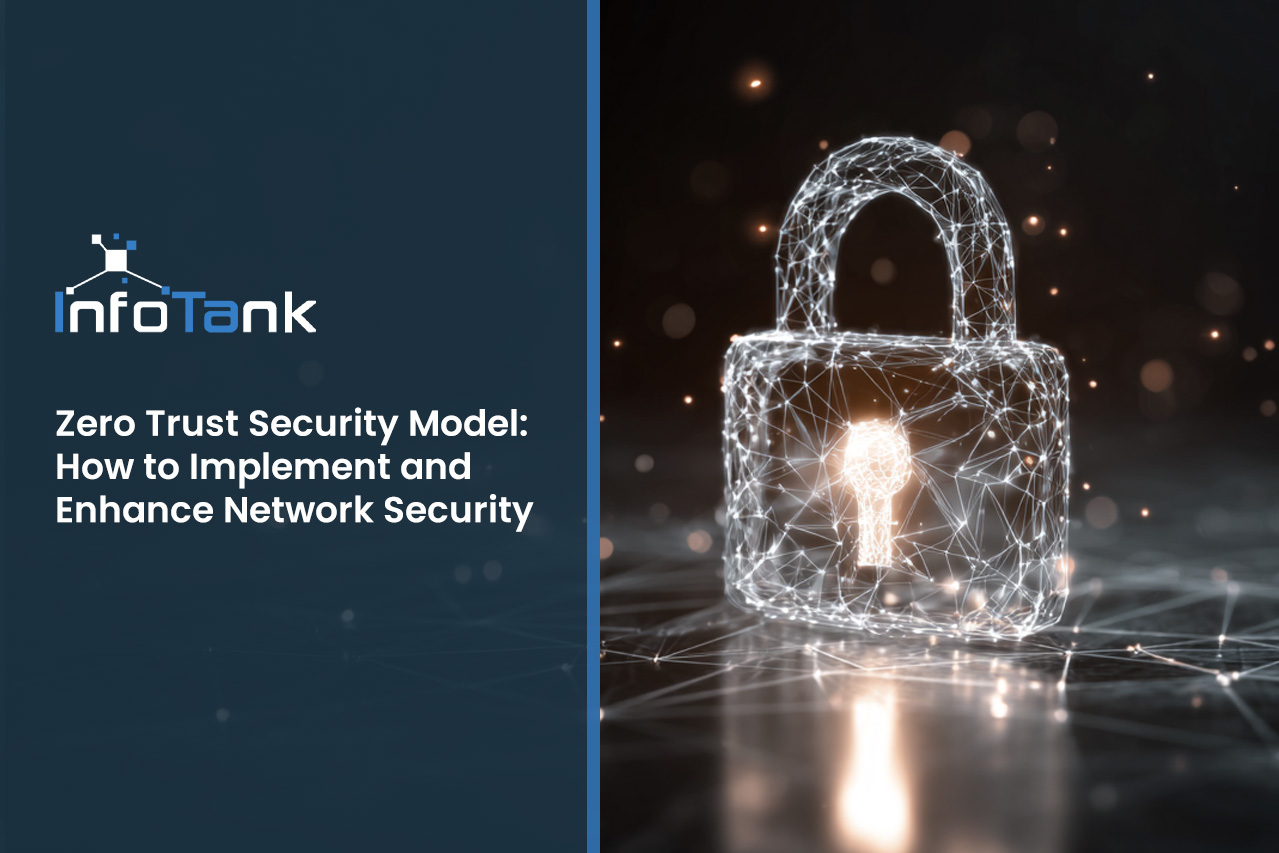
Zero Trust Security Model: How to Implement and Enhance Network Security
The zero trust security model is changing how businesses protect their data and systems. Instead of assuming everything inside the network is safe, this model treats every user and device as a potential threat. In this blog, you’ll learn what zero trust is, how it differs from traditional network security, and how to implement it effectively. We’ll also cover the key benefits, common challenges, and practical steps to help you adopt a zero trust approach that fits your business.
Understanding the zero trust security model
The zero trust security model is based on a simple principle: never trust, always verify. It assumes that threats can come from both inside and outside the network. This is a shift from the traditional network model, which often trusts users and devices once they’re inside the network perimeter.
With zero trust, every access request is verified based on user identity, device health, location, and other factors. This model uses strict access controls, continuous monitoring, and segmentation to reduce the risk of breaches. It’s especially useful in environments with remote workers, cloud services, and IoT devices.
Zero trust security models are not one-size-fits-all. They require a tailored approach that fits your existing infrastructure and business goals. By focusing on identity, access, and device verification, the zero trust model of information security helps businesses improve their overall security posture.

Key strategies to make zero trust work for your business
To get the most from your zero trust implementation, follow these proven strategies. Each one supports the core idea of verifying every access request, no matter where it comes from.
Strategy #1: Start with identity and access management
Strong identity and access management (IAM) is the foundation of zero trust. Use multi-factor authentication (MFA) and role-based access controls to limit who can access what. This reduces the chance of unauthorized access.
Strategy #2: Segment your network
Divide your network into smaller zones. This limits how far an attacker can move if they get in. Microsegmentation helps isolate sensitive data and systems.
Strategy #3: Monitor all network activity
Use tools that track user behavior and network traffic. This helps you detect unusual activity early. Continuous monitoring is key to spotting threats in real time.
Strategy #4: Apply least privilege access
Give users the minimum level of access they need to do their jobs. This limits damage if an account is compromised. Review permissions regularly.
Strategy #5: Secure endpoints and devices
Make sure all devices connecting to your network meet security standards. This includes laptops, mobile phones, and IoT devices. Use endpoint detection and response (EDR) tools.
Strategy #6: Use cloud-native security tools
If your business uses cloud services, choose tools that are built for cloud environments. These tools integrate better and support zero trust policies more effectively.
Strategy #7: Train your team
Employees are often the weakest link. Provide regular training on phishing, password hygiene, and secure access practices. A well-informed team supports your zero trust goals.
Key benefits of adopting a zero trust model
Here’s what you gain when you implement zero trust security:
- Reduces the impact of data breaches by limiting lateral movement
- Improves visibility into user activity and network traffic
- Supports compliance with data protection regulations
- Enhances security for remote and hybrid workforces
- Protects sensitive data across cloud and on-premise systems
- Adapts to modern threats with continuous verification

How zero trust differs from traditional network models
Traditional network security assumes that everything inside the network is safe. Once a user or device passes the perimeter, they often have broad access. This approach worked when most systems were on-premise and users were in the office.
Zero trust flips that model. It assumes that no user or device should be trusted by default—even if they’re inside the network. This is especially important today, when users access data from multiple locations and devices. zero trust network access ensures that every request is verified before access is granted.
By moving away from the traditional network mindset, businesses can better protect against insider threats, compromised credentials, and advanced cyberattacks.
Core principles behind zero trust implementation
Zero trust isn’t just a set of tools—it’s a mindset. These principles guide how you design and manage your security systems.
Principle #1: Never trust, always verify
Every access request must be verified, regardless of where it comes from. This reduces the risk of unauthorized access from both inside and outside the network.
Principle #2: Assume breach
Design your systems as if a breach has already occurred. This helps you limit damage and respond faster when something goes wrong.
Principle #3: Enforce least privilege
Users and devices should only have access to what they need. This limits the potential impact of compromised accounts.
Principle #4: Monitor continuously
Track all user activity and network traffic. Use analytics and automation to detect and respond to threats in real time.
Principle #5: Secure every device
Apply security controls to all devices, including IoT devices and mobile phones. Make sure they meet your security standards before granting access.
Principle #6: Use strong authentication
Require multi-factor authentication for all users. This adds an extra layer of protection against stolen credentials.
Principle #7: Protect data everywhere
Encrypt data in transit and at rest. Apply security policies consistently across cloud, on-premise, and hybrid environments.

Practical steps to implement zero trust security
Implementing zero trust security takes planning and effort. Start by assessing your current security posture. Identify gaps in user access, device management, and network segmentation.
Next, define your security policies. Decide who should have access to what, and under what conditions. Use tools that support zero trust principles, such as identity providers, endpoint protection platforms, and network segmentation tools.
Finally, roll out your zero trust solution in phases. Start with high-risk areas, such as remote access or sensitive data. Monitor results and adjust your strategy as needed.
Best practices for maintaining zero trust systems
To keep your zero trust model effective, follow these best practices:
- Review access permissions regularly and remove unused accounts
- Update your security policies as your business evolves
- Test your systems with simulated attacks to find weaknesses
- Keep software and firmware up to date on all devices
- Work with partners who understand zero trust adoption
- Document your security controls and review them often
Staying proactive helps you adapt to new threats and maintain a strong security posture.

How InfoTank can help with zero trust security model
Are you a growing business looking to improve your cybersecurity? If you're managing sensitive data or supporting a remote workforce, the zero trust security model can help you stay protected.
At InfoTank, we help businesses plan, build, and manage zero trust security models that fit their needs. Our team understands how to align zero trust strategies with your existing systems. Contact us today to see how we can help you enhance your network security.
Frequently asked questions
What is the main difference between zero trust security and traditional models?
Zero trust security treats every user and device as untrusted by default. Unlike traditional network models that rely on a secure perimeter, zero trust verifies every access request. This approach helps protect against threats that originate inside the network and supports better security controls across cloud and hybrid environments.
By using zero trust architecture, businesses can reduce the risk of lateral movement and unauthorized access. It’s a more flexible and secure way to manage modern IT environments.
How does zero trust network access improve security?
Zero trust network access (ZTNA) limits access to specific applications and services based on user identity and device health. It doesn’t allow broad access to the network like VPNs do. This reduces the attack surface and helps prevent unauthorized access.
ZTNA supports a zero trust approach by enforcing strict access policies and monitoring network traffic. It’s especially useful for remote workers and third-party vendors who need limited access.
Why should we implement zero trust in our business?
Implementing zero trust helps protect your business from data breaches, insider threats, and compromised credentials. It’s a proactive way to secure your systems and data.
With zero trust strategies in place, you can enforce strong authentication, monitor user behavior, and apply consistent security policies. This improves your overall security posture and supports compliance requirements.
What are the principles behind zero trust that we should follow?
The main principles behind zero trust include never trust, always verify; assume breach; enforce least privilege; and monitor continuously. These principles guide how you design and manage your security systems.
By applying these principles, you can build a security approach that adapts to modern threats. It also ensures that every access request is verified before being granted.
How do we implement zero trust security without disrupting operations?
Start by identifying high-risk areas and applying zero trust policies there. Use tools that integrate with your existing systems to reduce friction. Roll out changes in phases and monitor results.
Implementing zero trust security doesn’t have to be disruptive. With careful planning and the right tools, you can improve security while keeping your operations running smoothly.
What are some real use cases for zero trust?
Zero trust is useful in many scenarios, such as securing remote access, protecting sensitive data, and managing third-party access. It’s also effective for controlling access to cloud services.
By applying zero trust policies, you can ensure that only verified users and devices can access critical systems. This helps enhance security and reduce the risk of breaches.



